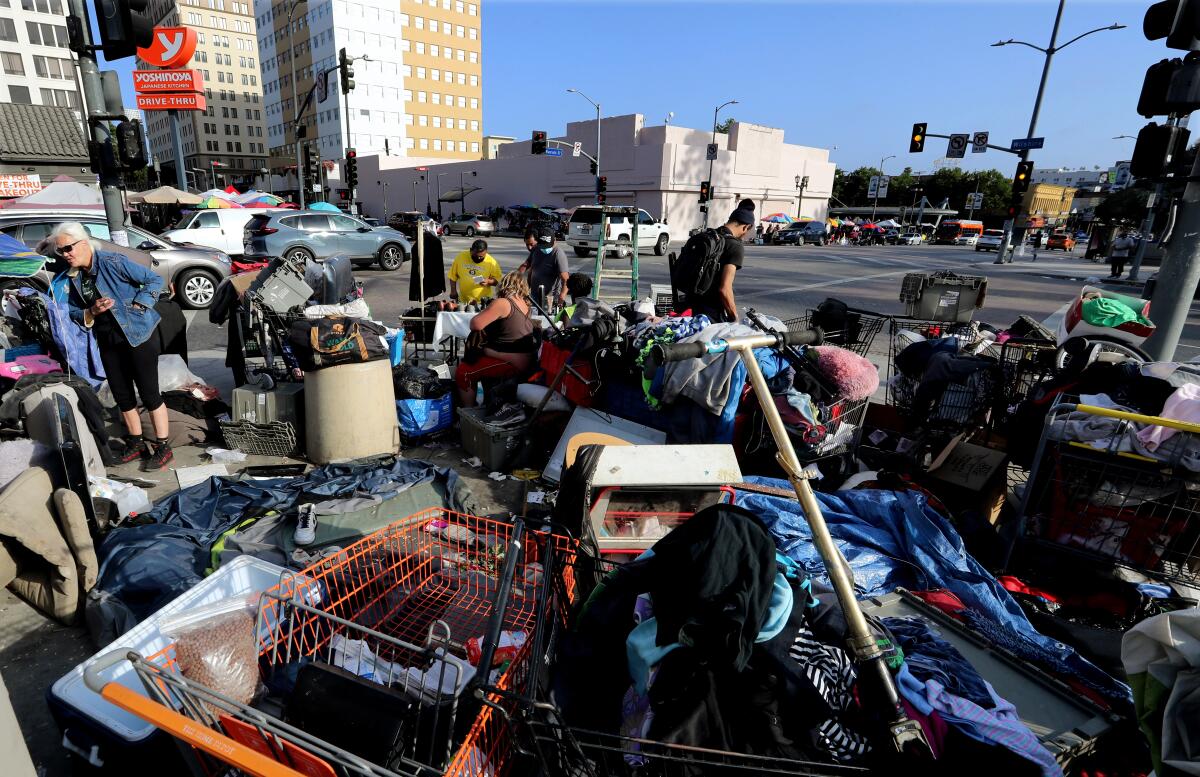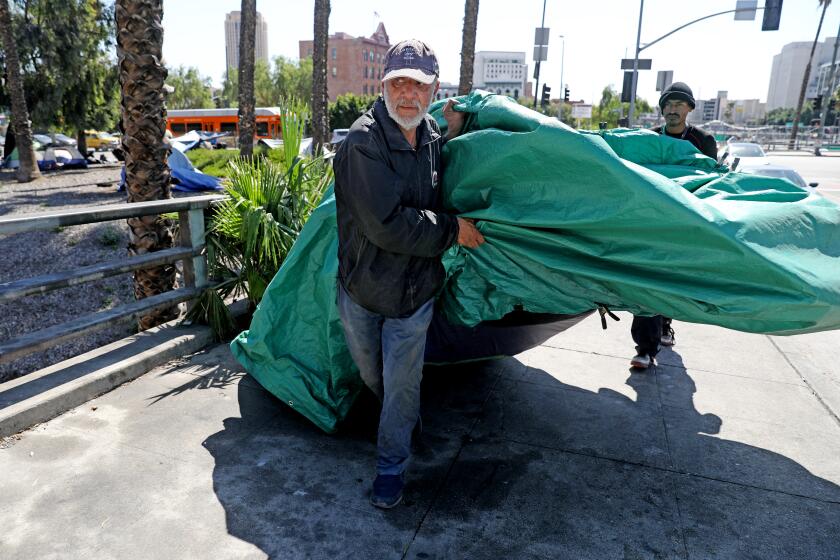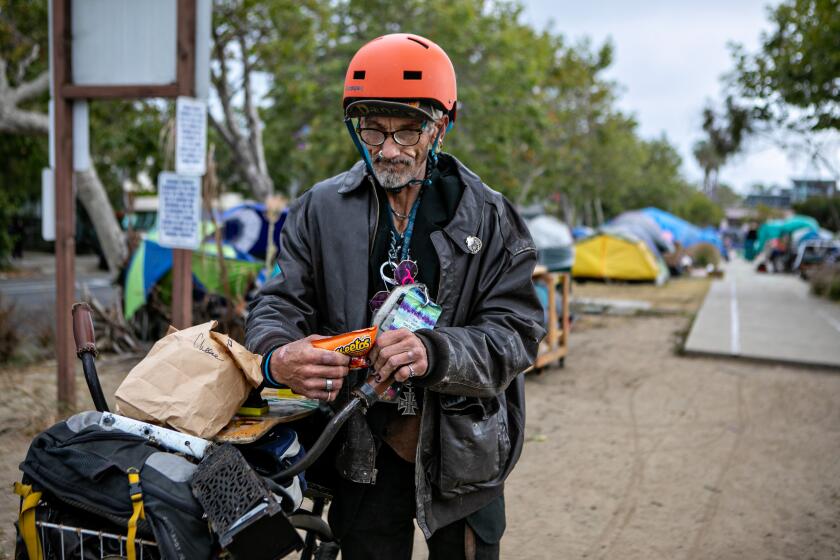Mobile phones give researchers a deeper look into living homeless in L.A.

- Share via
When USC researchers set out to document the effects of the digital divide on homeless people, they made an unexpected finding: 94% of their survey participants owned a cellular phone.
Leveraging that knowledge, a crosstown team from USC and UCLA — drawn together by a common social mission — has been conducting a novel survey of the Los Angeles homeless population.
Offering $10 gift cards as incentives, the researchers are asking participants to sign onto a mobile phone app monthly to report where they stay, how they feel, what kind of help they’re getting and how they’re affected by policies such as the anti-camping ordinance newly in force in the city.
Their goal is to fill what they describe as a “near-total lack of comprehensive, high-quality evidence on the well-being, needs, or desires of the unhoused community” that pervades “every stage of L.A.’s emerging homelessness crisis — and the increasingly reactive response from policymakers.”
A preliminary report released Wednesday by USC’s Homeless Policy Research Institute gives a qualified assessment of their success. In it, they say their phone sample closely matched the known demographics of the homeless population, indicating that it could provide reliable insights into the hidden dynamics of homelessness and how those are affected by public policies.
But a lot more work needs to be done before they can fine-tune politically pertinent information such as where people go after being cleared from an enforcement zone.
“In some ways it’s just a more general survey at this stage about what do people know about these camping laws and do they think it’s going to affect them,” said co-author Benjamin Henwood, professor in USC’s Suzanne Dworak-Peck School of Social Work.
Still, “Under Threat: Surveying Unhoused Angelenos in the Era of Camping Enforcement” provides new insight into how L.A.’s revised anti-camping ordinance and laws in other cities are viewed on the street. Barely a quarter of homeless people feel informed about the laws, while 43% said they think they will be forced to move and another 30% had no opinion.
Nearly 20% said they had contact with police in the past 30 days, and 7% said they had been cited for staying on the street.
Enforcement of Los Angeles’ revised anti-camping law rolls out in slow and uneven steps.
The report gives a nuanced picture of the street population. While all respondents were recruited on the streets, many said they go back and forth between being sheltered and unsheltered. About 16% said they were living in shelters and 8% said they were housed, primarily by doubling up. Nearly a third reported living in vehicles.
Attitudes about shelter were consistent with the findings of other studies, among them that a high percentage of homeless people would accept offers of housing, but that the type of housing matters. Fewer than 20% said they would go to a shelter where people sleep in the same large room. Privacy, safety, cleanliness, curfews and conflicts with staff were the main objections.
Respondents also had “exceptionally worse physical and mental health outcomes” than the adult population of Los Angeles County. Half reported symptoms of anxiety and slightly less reported depression. Forty-nine percent rated their health as fair or poor compared with 17% countywide. Women were more likely than men to describe their health as fair or poor, and 63% reported psychological distress compared with 39% for men.
A homeless man with a hoarding disorder bounces between motels under a voucher program. But every move can be devastating.
Smoking was more than twice as prevalent among homeless people, and the rate of COVID-19 vaccination was less than half the county average.
Three-quarters reported experiences with food insecurity compared with 15% for the county.
What the report could not do, yet, is track these statistics by time and location. It summarizes only the initial survey taken by 411 participants and a one-month follow-up taken by 258. A richer picture will come from the monthly follow-up surveys that are continuing if more respondents are recruited.
“Our ability at this sample size to, say, precisely associate a person’s presence specifically in an enforcement zone with a set of outcomes will be complicated,” according to co-author Randall Kuhn, professor in UCLA’s Fielding School of Public Health. “Doubling the sample size will help.”
Enrolling participants proved difficult and keeping them engaged even more so, Kuhn said. They are learning as they go. Raising the incentive, initially $5, to $10 helped.
Their funding, provided by the Conrad N. Hilton Foundation, has been extended, and they’ll resume recruiting next year.
After experimenting with different approaches, they plan to piggyback on the survey of 5,000 homeless people conducted each year as part of the point-in-time count. After asking the survey questions, the interviewers will give each participant a pitch to enroll in the mobile app survey program.
“We learned some things,” Kuhn said. “The best approach is you spend 15 minutes doing the demo survey and build a certain rapport.”
The mobile phone survey, formally the Periodic Assessment of Trajectories of Housing, Homelessness and Health Study or PATHS, is part of a growing body of academic and nonprofit work aimed at addressing the inadequacies of the large count mandated every two years by the U.S. Department of Housing and Urban Development but conducted annually in many places, including Los Angeles.
“Using the point-in-time count is like taking a photo with an early model camera where the picture is distorted if the subject moves,” proclaims a critique on the website of Built For Zero, a homelessness initiative of the nonprofit Community Solutions, articulating a widespread complaint about the count. “Homelessness is always in flux, and the picture takes time to develop, in this case many months. The result is a hazy picture of the past.”
Built For Zero encourages communities to build “by-name” lists by combining information compiled by outreach workers with data from service providers outside the HUD-mandated system and to report that information to the public as it is gathered.
That would be a challenge for a homeless population as large and dispersed as in Los Angeles. One troubling finding of the mobile phone survey was that 33% of respondents said they had no contact with outreach workers.
The LAHSA count found that there were no unsheltered people in the northwest quarter of Venice.
Unlike some critics of the annual count, Kuhn and Henwood are not seeking to replace it. They both work on it and see it as an essential part of what Kuhn calls the homeless data ecosystem.
“I think the PIT count is wonderful,” Kuhn said. “To me the PIT count is another data point in a year-round story.”
“It’s a community involvement endeavor as much as anything else,” Henwood said. “And so there is value in that.”
They hope to add value to it, particularly with timeliness.
“We hope we get to the place where we have the capacity to essentially put the data up as soon as we get it,” Kuhn said.
They also are adding depth to the check-box questions asked year after year in the demographic survey.
“A lot of time the respondent would say, ‘I wish you were asking me questions that are more interesting,’” Kuhn said. “In a lot of encounters a person will say, ‘Will you ask me a question about how I feel about things?’”
The mobile survey, by contrast, gathers qualitative responses.
“The amount of bullying, psychological and emotional abuse that I have been subjected to by other clients … and outright abusive security guards,” one Black woman exclaimed about her shelter. “These places keep you mentally messed up.”
“Rules are prioritized over human needs,” a white man living outdoors said of his shelter experience.
Of all the obstacles the researchers face, crosstown rivalry is not among them.
“I’m not local, so this whole rivalry thing was not a thing,” Henwood said.
Kuhn, with degrees from UC Berkeley and the University of Pennsylvania, and Henwood, who’s been awarded degrees by Swarthmore and New York University, were brought together by their personal desire to do something about homelessness.
“This is hard work and I think we both have other projects that are better funded,” Kuhn said. “But we love this work.”
More to Read
Sign up for Essential California
The most important California stories and recommendations in your inbox every morning.
You may occasionally receive promotional content from the Los Angeles Times.

















